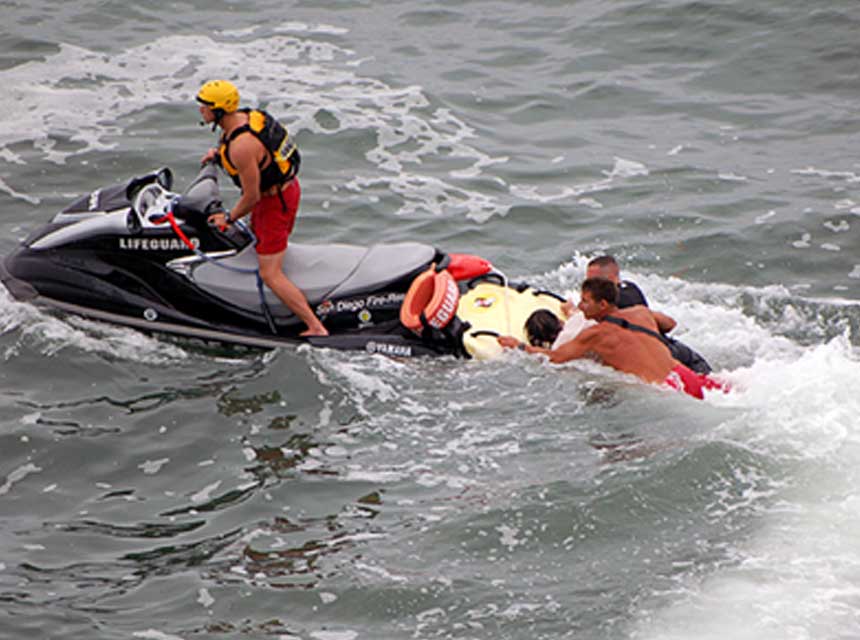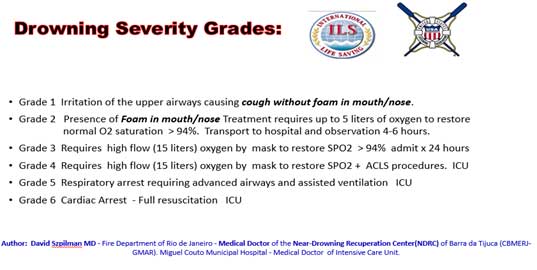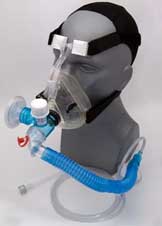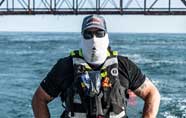By Mike Hudson
In the United States, fire fatality rates are miniscule when compared to drowning fatality numbers. Depending on where they are based, some firefighting teams are more likely to pull a viable victim from the water than from an active structure fire. Numerous cases of firefighter drowning morbidity and mortality throughout the last 50 years have forced the fire service to put firefighter safety firmly above all other priorities, including rescue and recovery of civilians. The National Fire Protection Association (NFPA) has created standards for water rescue teams in the name of firefighter safety. Under NFPA Standard 1006 and NFPA 1670, fire service water rescue teams should meet certain hallmarks of training and physical fitness before a department formally accepts a duty to respond to aquatic emergencies.1 Long gone are the days of random engine companies without proper training and equipment being dispatched alone to effect technical water rescue.
Fundamentals of Open Water Rescue
Drifting Towards Catastrophe: What Water Rescue Teams Can Learn from Air Medevac Procedures
Training Minutes: CPAP Applications
As a rescue swimmer, there are few words that come over the radio that stir emotion and stimulate the human stress response like the words “submerged victim.” For company officers, the sight of a rescue swimmer outside the surf zone giving the arm signal requesting assistance for a resuscitation case will set several procedures in motion. These are focused on getting trained assistance to the rescuer and preparation for the resuscitation case on dry sand, and are the times when a water rescue team needs to be firing on all cylinders. The rescue swimmer in control of an unresponsive victim must remain calm so that they can safely perform the rescue, as that is their only goal until they reach shore. Once the victim is on shore resuscitation begins without delay. Drowning induced cardiac arrest survival boils down to the victim’s submersion time, the time it takes to effect rescue, and the immediate initiation of uninterrupted cardiopulmonary resuscitation (CPR) by clinically competent rescuers.2,3,4 Submersion times of greater than 10 minutes or a delay in CPR greater than 10 minutes dramatically reduces the probability of successful resuscitation.2,3,5,11 A drowning full arrest resuscitation that starts with a greater than 10 minute rescue procedure without CPR followed by 20 minutes of CPR without return of spontaneous circulation (ROSC) indicates that death is likely.2,3,5
Top 10 Rules of Open Water Rescue and Resuscitation
Procedural pearls of rescuing an unconscious victim vary from service to service but here are a few things that should hold true for every water rescue team and every rescue swimmer.
- No rescuer should enter the water to effect rescue unless trained to do so. Rescues of unconscious victims from the water most often requires multiple rescuers, especially in big surf or rescues involving swiftwater hazards.
- Condition your body as if your life depends on it. Train all the time because your victim’s life depends on it.
- The focus of any water rescue operation should be on removing the victim from the water as quickly as possible. 3,4
- Rescuers must know universal nonverbal methods to communicate in the water from a distance using arm signals.
- Fins are mandatory safety equipment for open water rescue swimmers and rescue watercraft (RWC) operators, especially in the surf.4
- Best practices dictate that the primary rescuer is trained to the technician level and must be proficient at using a rescue flotation device (RFD) and rescue fins to effect open water rescue—most time that is all you need. 1,4
- Cervical spine motion restriction (CSMR) is no longer required for an unresponsive drowning victim unless obvious head trauma or an axial loading mechanism is suspected (such as with a shallow water diving injury 11).
- Drowning is a hypoxic event; all focus should be treating hypoxemia to prevent hypoxia.
- Resuscitate victims on dry sand. It’s usually just a few more steps but makes all the difference in medical equipment function and rescuer comfort; no paramedic wants to intubate a patient in wet sand.
- The preferred position for treating a conscious drowning victim is sitting up in high Fowler’s position. For cardiac arrest secondary to drowning, there is no one preferable position for the victim. Position supine in an area that will allow safe administration of resuscitation procedures with enough room for rescuers to move around the victim and switch positions freely.
Drowning Definition
Drowning is defined as respiratory insufficiency caused by fluid in the lungs impeding gas exchange. Drowning is either fatal (mortality) or non-fatal with injury (morbidity). “Near drowning” and “dry drowning’ are no longer used to identify acuity of the drowning victim.
Drowning: Case Review
This is case is from a real incident that occurred in a large municipal department. Abbreviations are used rather than the names out of respect for the department and the fallen.
When the engine company arrived at the flooding intersection that afternoon, dozens of cars were stalled in deep water. Firefighter RC and his partner BR spotted a woman clinging to a metal pole in what appeared to be waist-deep water. They were not aware that the woman was standing on the edge of a 10-foot-deep culvert. Both firefighters had no formal water rescue training nor did either firefighter possess the proper equipment or flotation devices to effect a safe water rescue. Heroically, both firefighters, naive to the unseen hazards and depth of water and without a safety line or life jackets, moved towards the stranded victim. Wearing only a T-shirt, yellow bunker pants with suspenders, and typical rubber structure-fire boots, the firefighters approached the woman when BR slipped into the culvert. Luckily firefighter RC was able to rescue his partner. RC then attempted to move towards the victim, but he too immediately lost his footing. The firefighter’s turnout gear quickly filled with water and he was swept into a swirling pool of black water storm runoff with hundreds of gallons per second moving through a large, overwhelmed, grate covered drainage pipe, unabated and chock full of hidden hazards. Firefighter RC disappeared under the black water in a matter of seconds, according to witness statements, and was never seen alive again. After an exhaustive and emotional recovery operation led by RC’s partner and fellow firefighters, RC’s body was found five hours later in a small drainage ditch more than two blocks away from the point last seen. The original victim survived.
Pathophysiology of the Drowning Event
It is unknown what happened to the firefighter once he disappeared under the water. The following breakdown is not reflective of the above case presentation, rather it is an example of the usual progression of typical drowning pathophysiology beginning with a struggling victim screaming for help-
The mere physical exertion of panic coupled with struggling in the water to stay alive initially causes the victim’s respirations to increase to accommodate the body’s demand for more oxygen and need to remove (exhale) CO2. Ultimately, instead of air the victim eventually inhales large amounts of water into the oropharynx, leading to laryngospasm and/or bronchoconstriction. The more a victim struggles, the quicker the deterioration as skeletal muscle tissue and myocardial oxygen demand progressively increase. The extreme muscle exertion during survival mode also concurrently increases systemic levels of carbonic acid and lactic acid. Quickly, water advances deeper into the lungs, blocking the smaller airways and rapidly impeding further gas exchange, causing hypoxemia. Rapidly, acute respiratory distress sets in, secondary to pure exhaustion and extreme muscle fatigue, causing a further drop in oxygen levels in the blood supply leading to the tissues of life-sustaining organs. The inevitable alveolar hypoventilation results in hypoxia, causing unconsciousness and more progressive CO2 retention, which creates fatal systemic levels of acid in the tissues and bloodstream. Because the victim cannot protect his or her airway and the body’s vegetative response to breathe even when submerged, more water enters the airways and causes lung tissue to swell and the alveoli to collapse (atelectasis). Global systemic hypoxia is inevitable, followed by cardiac arrest.
The body finally succumbs to the drowning process. After 10 minutes of clinical death and still submerged under water, all body tissue and critical organs like the brain, lungs, kidneys, and heart become anoxic and begin to infarct, leading to significant irreversible tissue death and neurological damage (biological death). Within 20 minutes of being submerged, the victim’s body progresses to a state of “end organ failure” and irreversible biological death.

Assessment of a Drowning
The American Heart Association (AHA) recommends the following ABC approach rather than the typical CAB assessment. The ABC order of the assessment is meant to address the hypoxic origin of a drowning case.3,4
- Responsiveness: Using AVPU (alert/verbally responsive/painfully responsive/unresolved), assess the victim’s level of consciousness (LOC), specifically their ability to manage their own airway by controlling their secretions and protecting themselves from extrinsic fluid.
- Airway: Open the airway using either the head-tilt-chin-lift or jaw thrust, assess patency, suction to clear for ventilation, and manage as indicated.
- Breathing– Assess rate, depth, and quality of breathing immediately after securing the airway. Assess your patient’s lung sounds early, listening specifically for crackles or rales at lateral and posterior points, indicative of liquid in the lungs. If the patient is not breathing, begin artificial ventilations using a bag-valve-mask (BVM) with positive end-expiratory pressure (PEEP). If the patient requires only ventilatory assistance, manage as indicated at an age-appropriate rate with supplemental oxygen.
- Circulation– Check for a pulse. If a pulse cannot be palpated and the victim is in respiratory arrest, initiate high-quality chest compressions immediately. Check for uncontrolled bleeding if indicated by the incident.
Lung Sounds: Assess your patient’s lung sounds early and repeatedly. Crackles (rales) may be heard, especially at the base of the lungs if the patient has aspirated fluid into the lower airways. Diminished breath sounds or absent breath sounds can indicate significant aspiration, pulmonary edema, atelectasis, or bronchoconstriction. Saltwater aspiration can lead to extrinsic pulmonary edema and acute respiratory distress syndrome; fresh water usually causes very little edema to occur. Rapid aspiration of water can cause upper airways and lower airways to constrict quickly indicated by stridor, wheezing, and diminished breath sounds.
Assess for Hypoxia:The rescue swimmer should assume that a patient is hypoxic following a submersion event, however pointless administration of oxygen is no longer accepted as the standard of care. The rescue swimmer should assess the patient’s need for supplemental oxygen while administering oxygen.
Some of the more common indications for oxygen administration during a drowning case:
- Rapid or very slow respirations, a.k.a. tachypnea and bradypnea
- Dyspnea with the inability to maintain an SpO2 >94% per AHA Guidelines 2,3
- Altered mental status, including victims presenting as obtunded, confused, lethargic or unresponsive
- Agonal breathing (late sign) considered by most as an ominous sign of a hypoxic brain and peri-arrest
- Signs of cyanosis
- Cardiac or respiratory arrest

BLS Emergency Care
The 2020 AHA ECC Guidelines recommend the “ABC” treatment approach for drowning victims3. For those unresponsive drowning victims without signs of life, compressions should never be delayed. Though only one study cited by the AHA on this matter suggests improved survival rates with in-water ventilations, rescuers should avoid infectious risk and refrain from mouth-to-mouth, mouth-to-nose, or mouth-to-mask ventilation. If there are no signs of life and once on dry sand, start high quality uninterrupted compression-only CPR (CO-CPR) without delay, and then manage the airway and breathing when properly equipped to safely do so.
- Position the conscious drowning victim sitting up in high Fowler’s position.
- Immediately address hypoxia with supplemental oxygen using a high-flow delivery device with >90% FiO2 delivery capability.
- Consider continuous positive airway pressure (CPAP) with PEEP if indicated and within scope of practice.
- Maintain patient warmth and prevent heat loss.
- Monitor SpO2 and maintain at or above 94%.
- If the airway cannot be managed or the patient’s oxygen saturation remains low after two to three minutes of supplemental O2, request ALS paramedic intercept and transport immediately.

Key Learning Point: CPAP is categorized as a high-flow, positive pressure oxygen delivery system which is indicated to treat pulmonary edema. The use of CPAP by EMT personnel is rapidly becoming the nationwide standard of care for acute pulmonary edema and reactive airway problems in the prehospital setting, but its use is dependent on local EMS protocols. CPAP devices are noninvasive and use specialized oxygen tubing and a mask to seal the patient’s face from the outside atmosphere to deliver a continuous flow of oxygen under pressure to the lower airways. This pressure keeps the lower airways open and displaces fluid from the alveolar capillary membrane long enough for gas exchange to occur. People compare the sensation of CPAP to putting their face out of the window of a car traveling at 60 miles an hour. The patient must be awake, cooperative, and breathing to use this device. See photo at left.

Safety Second Resuscitation Practices?
Based solely on a single pediatric specific drowning completed in 1993, the AHA thinks it may be prudent to administer in-water rescue breathing in the form of mouth-based ventilation if scene safety permits. This recommendation is for lifeguards and water rescue professionals for all victim age groups. Mouth-driven, in-water ventilations given before swimming the victim to shore or once in shallow water will increase survival, according to the AHA.3,4,9 Unfortunately the recommendations for mouth-based procedures don’t come with equal stress on the real-life consequences of contagious disease exposure during resuscitation. Over the last year, infectious disease has led to hundreds of documented first responder line-of-duty illnesses and fatalities.7,8 The good news is that the 2020 AHA guidelines have recognized that passive oxygenation with compression only CPR (CO-CPR) has very similar survival rates and even improved survival rates when compared to CPR with integrated ventilations during out-of-hospital cardiac arrest.-6 More data is needed for the AHA to take a more definitive stance on prioritizing CO-CPR for drowning in particular. It may be time to stress high quality uninterrupted CO-CPR coupled with apneic ventilation and oxygenation via non-rebreather mask or high-flow nasal cannula as a much safer alternative to CPR with assisted ventilations.6 Medical professionals should never disregard the rules of body substance isolation (BSI). The one thing that is definite is that prehospital clinicians and professional first responders should never use their mouth to perform any medical procedure. No cardiac arrest treatment plan should ever require the provider put their safety second and disregard the standard core rules of BSI precautions just to increase their chance of successful resuscitation, regardless of the results from a single pediatric drowning study with fewer than 167 patients completed over 25 years ago.9,10
BLS Resuscitation Considerations: Spinal Injury
The AHA guidelines for special circumstances of resuscitation documents the reported incidence of cervical spine injury in drowning victims is low (0.009%). They recommend that unnecessary cervical spine immobilization can impede adequate opening of the airway and delay delivery of rescue breaths. Routine stabilization of the cervical spine in the absence of circumstances that suggest a spinal injury is not recommended (Class III, LOE B).3, .4, 11
Gastric Distension
Aspiration of gastric contents is a high-risk/high-probability complication during drowning resuscitation and preventing it is one the goals of airway management. Two studies find that postmortem exams of drowning victims show more than 80 percent of fatalities involve gastric distension and aspiration of gastric fluids.4 , 12 During the primary assessment it may be necessary to suction the airway immediately to manage its patency and assess breathing. Suction should always be right next to provider who is managing the airway. The use of an oropharyngeal airway will help facilitate suctioning of the posterior oropharynx. Rescuers should not use the Heimlich maneuver to relieve gastric distension. Paramedic personnel should consider placement of an nasogastric tube to relieve distension even before intubating the patient.
Drowning BLS Resuscitation
- Initiate resuscitation without delay and without interruption.
- Manage the airway with an adjunct and the appropriate airway maneuver.
- Consider supraglottic rescue airway placement if within local scope.
- Treat hypoxia aggressively with high flow oxygen to the BVM device.
- Ensure that the PEEP valve is being utilized with BVM device.
- Integrate AED as early as possible, preferable within the first three minutes of arrest.3
- If resuscitation is going to be successful, return of spontaneous circulation (ROSC) must occur within 20 minutes of CPR initiation.
- Any patient who as been submerged for over 30 minutes will likely have systemic biological death.
- No resuscitation is indicated for those victims who have been submerged for > 60 minutes 2, 3, 4 realistically that time frame is much shorter by almost 40 minutes for a positive neurologic outcome after ROSC.
Key Learning Point: The PEEP valve is a device designed to provide extra airway pressure at the end of exhalation. This extra pressure keeps the lower airways open a little longer to allow gas exchange to occur. PEEP valves can be used in conjunction with CPAP or BVM devices.
*
Survival from a submersion event is dependent on quick rescue and an early decisive treatment aimed at abetting the drowning process. Since drowning is a hypoxic event, rescue swimmers must be proficient at aggressive airway management, oxygen administration, and manual ventilation without causing gastric distension. Obtaining an SpO2 is important, however patients should be treated based on their ability to function as well as their ability to manage their airway and respiratory processes. Studies have shown that simple measures such as sitting a conscious hypoxic patient upright and administering high-flow supplemental oxygen with a high FiO2 can quickly improve outcome.3,4,10 The key to success when treating a drowning is removing the victim from the water quickly and treating hypoxia aggressively.
REFERENCES
- Water Rescue 2nd edition, NFPA Standards and Practices 1006 and 1670. Steve Trienish. 2017. Jones & Bartlett Learning Public Safety Group.
- Survival in Out-of-Hospital Cardiac Arrest After Standard Cardiopulmonary Resuscitation or Chest Compressions Only Before Arrival of Emergency Medical Services, Gabriel Riva, Mattias Ringh, Martin Jonsson. AHA Journal. October 2019. https://www.ahajournals.org/doi/10.1161/CIRCULATIONAHA.118.038179
- 2020 AHA ECC Guidelines 2020-Part 3. Special Circumstances of Resuscitation. Published online, August 2020. https://cpr.heart.org/en/resuscitation-science/cpr-and-ecc-guidelines/search-guidelines?searchText=special+situations#q=special%20situations&sort=relevancy
- Manual of Open Water Lifesaving 3rd edition, USLA Manual B. Chris Brewster. Pearson Publishing, 2017.
- “EMS Termination Of Resuscitation And Pronouncement of Death.” C. Libby. R. Skinner. NCBI. StatPearls published and updated October 27, 2020. https://www.ncbi.nlm.nih.gov/books/NBK541113/
- “Passive Ventilation: Passive oxygen flow better than assisted ventilations.” University Id Arizona School of Medicine. https://opa.uahs.arizona.edu/newsroom/news/2009/cardiac-arrest-resuscitation-passive-oxygen-flow-better-assisted-ventilation
- “COVID-19 confirmed cases in public safety.” Local government. Published April 4,2020. https://www.gov1.com/coronavirus-covid-19/articles/covid-19-confirmed-cases-in-public-safety-local-government-cqEZLQNNSfS6RLnK/
- Officer Down COVID-19 Memorial Page. US LEO LODD. https://www.odmp.org/search/incident/covid-19
- 2015 AHA ECC Guidelines – Special Circumstances of Resuscitation. Section 12. https://www.ahajournals.org/doi/10.1161/CIRCULATIONAHA.110.971069 ‘
- “Effect of immediate resuscitation on children with submersion injury.” Pediatrics. 1994; 94(pt 1):137–142. Kyriacou, DN. Arcinue, EL. Peek, C. Kraus, JF.
- Pre-Hospital Trauma Life Support, 9th edition. Published 2019. Jones & Bartlett Learning Public Safety Group.
- “Autopsy findings and drowning death.” P. Lunetta, Encyclopedia of Forensic and Legal Medicine (Second Edition). 2016. https://www.sciencedirect.com/topics/medicine-and-dentistry/dry-drowning

Mike Hudson is a nationally registered paramedic with over 25 years on the streets. He is a former U.S. Navy Corpsman, San Diego County (CA) and Denver City and County (CO) paramedic. Mike currently works as a street-level MICP and EMS educator in central New Jersey. In the winter, he also works for the Discovery Channel and NatGeo as a dive safety supervisor. During the summer, Mike commands two municipal USLA certified lifeguard programs for separate coastal towns along the Jersey Shore. He also serves as the commanding ocean rescue specialist for a nationally recognized combination fire department/lifeguard water rescue team, SRT 43-88, headquartered along the north shore of Monmouth County, New Jersey. For more on Sea Bright Ocean Rescue, go to seabrightoceanrescue.com.

